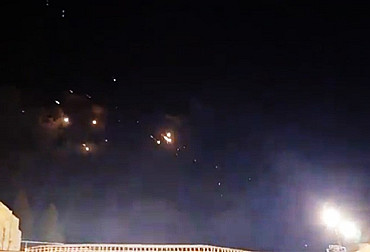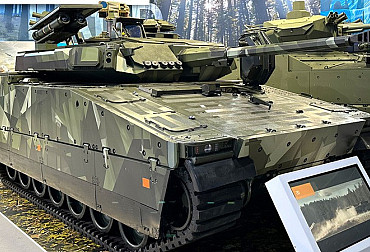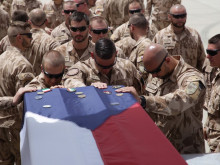MASCAL exercise tested the cooperation between the Multinational Battle Group in Slovakia and the IRS
Within the framework of the Multinational Battle Group Slovakia (MN BG SVK), not only the military readiness of allied units is exercised, but also the cooperation of the armed forces with the Integrated Rescue System (IRS) and the private medical sector, as our editorial team could recently see for itself during the three-day exercise MASCAL Plan (Mass Casualty Response Plan), which was attended by approximately 200 participants. "In addition to the five different nations of the multinational battle group and the military firefighters from Sliač, personnel from the Rescue Medical Service Bratislava and ZaMED and the Regional Operations Centre of the Rescue Medical Service Bánská Bystrica were also present," introduced all the participants to the commanding staff sergeant major from the Military Medical Command Ružomberok, Radoslav Fabian.
Video: Report from the MASCAL exercise / CZ DEFENCE
Major Patrik Paleček, Medical Liaison Officer of the MN BG SVK Multinational Battle Group, said that the preparation of this type of exercise was born out of the need to verify standard operating procedures on how to respond to mass casualty events. "If we had a large number of wounded and we were unable to resolve it with normal medical forces and resources, this procedure (MASCAL, editor's note) sets out how to respond," Major Paleček revealed. "The Integrated Rescue System of the Slovak Republic is also involved. This has given us a unique opportunity to check whether we have processed the MASCAL procedure correctly, whether it will work and to verify our cooperation with the Integrated Rescue System," Paleček added. The whole event was especially beneficial for Multinational Battle Group Slovakia. "The benefit lies on several levels. Firstly, in terms of command and control systems, whether we are able to activate forces and resources, and of course it is also a great experience for the medical personnel and military police. It was the diversity of the different nations and the number of different units that gave all the trainers a hard time at the beginning. The big differences are mainly in the activation of the event itself. In a civilian environment they use the so-called METHANE report, in a military environment it is again the so-called 9-liner MEDEVAC Request. In triaging the wounded, everyone has a different process as well. The civilian ambulance service, unlike the military, does not use the P1-hold (expectant) category. These are seriously wounded people, who can be expected to die in the end, despite quick and high-quality treatment," described the major differences in the work of paramedics liaison officer Major Paleček, who added that even determining the location of the incident can properly complicate the whole situation. "NATO armies follow MGRS coordinates, while all civilian forces use WGS84."
And how does such an announcement of a MASCAL plan actually come about? According to Major Paleček, someone from the incident site needs to call the emergency number of Role 1, which is always the MN BG SVK doctor, who has a service phone and is always on call. Based on the description of the incident and the number of wounded, the physician will then evaluate whether the Mass Casualty Response Plan needs to be activated. "If so, he calls the task force commander to announce the MASCAL plan, and the individual forces and assets are then activated simultaneously," says Maj. Paleček. The medic also calls and activates civilian forces in parallel, via the 155 line. After inspecting the scene of the incident, the so-called triage (sorting patients according to their injuries) begins at the assembly area of the wounded. "The injured will be identified according to the colours belonging to each priority and basic medical care will be provided. This is then followed by the amount of personnel available on site. If there are enough personnel, they are distributed according to the category of the injured. Of course, those with the highest priority are given priority and are the first to be prepared for medical removal to a MEDEVAC or civilian medical facility where they are given higher medical care," described the procedure by Maj. Paleček.
 Picture: Soldiers simulating various types of injuries during MASCAL exercise | Daniel Špalek / CZ DEFENCE
Picture: Soldiers simulating various types of injuries during MASCAL exercise | Daniel Špalek / CZ DEFENCE
In the case of a recent MASCAL exercise, the rescue of persons after a bus and infantry fighting vehicle accident that left many injured was practiced. One of those who prepares the different types of injuries is the senior senior medical officer of the Headquarters of the Air Force of the Slovak Army, Sergeant First Class Peter Bučko. According to him, the variety of injuries is prepared to match the complexity of the situation and the medics had to quickly and efficiently use all the resources available to them during the intervention. The mannequins then faithfully mimic the injuries they are supposed to represent. According to Sergeant First Class Bučko, each manikin was instructed on how to behave on the scene. This is because injuries evolve over time and a rescuer must always recognize the right signs. The Slovak military medics prepared a variety of different injuries on more than 40 figurants for each day. "We want the range of emergency medical care to be as large as possible.

Picture: Mannequins faithfully imitated the injuries they were supposed to represent. | Daniel Špalek / CZ DEFENCE
That's why we had, for example, a fractured neck, which the medics only detected thanks to a hematoma behind the ear. There were also various types of pneumothoraxes, i.e. punctured lungs, or various arterial haemorrhages," said Sergeant First Class Peter Bučko, who again stressed that to make the whole situation authentic, all mannequins were instructed how to behave from the first to the last minute of the intervention. "They knew after how long they should fall unconscious, how they should communicate with the attendants and react to their suggestions. In the worst case scenario, if help did not arrive in time, they knew when their simulated death would occur," described the instruction by Sergeant First Class Bučko.
 Picture: In the case of a recent MASCAL exercise, the rescue of people after a traffic accident between a bus and an infantry fighting vehicle, which left many injured, was practiced. | Daniel Špalek / CZ DEFENCE
Picture: In the case of a recent MASCAL exercise, the rescue of people after a traffic accident between a bus and an infantry fighting vehicle, which left many injured, was practiced. | Daniel Špalek / CZ DEFENCE
We asked the regional chief paramedic Ján Šimko from the Bratislava Rescue Medical Service whether there is any difference between the procedures of the army and the integrated rescue system. "The differences are marked, for example in terms of the management system together with the activation of forces and resources. The exercise was also important for the medical staff in terms of new experiences in triage of the wounded, communication in English with other nations and different medical procedures in investigation," Šimko described.

Picture: Overturned bus with "injured" figures | Daniel Špalek / CZ DEFENCE
Colonel Karel Navrátil, commander of the Multinational Military Group in Slovakia, also sees the cooperation between the army and the state and private medical sector as crucial. "Bringing all these components together brings the ability to carry out more effective and efficient interventions to minimise the consequences of emergencies, where the priority in all circumstances is to save human lives and restore the standard functioning of the system in times of crisis. Here we had the opportunity to compare our military procedures with those experienced by our Slovak colleagues, and joint training of this nature is beneficial for all parties."





















